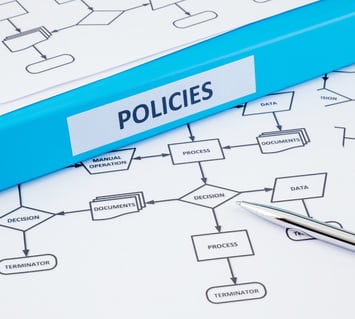By Jay Palter | August 3, 2023
Police fleet management is a complex process that can be both time and resource-intensive. Fleet managers have the difficult job of balancing maintenance schedules, vehicle availability, and officer safety, all while staying within prescribed policies and budgets.
Fortunately, recent advances in smart technology have opened up new possibilities for streamlining police fleet management processes. New technology won’t replace human fleet managers but will automate the tedious work of managing fleet vehicles.
This article explores everything you need to know about the state of police fleet management today. It covers everything from leading challenges most law enforcement fleet managers face, how technology has an increasingly important role, and some best practices for managing a 21st-century police fleet.
Key challenges in police fleet management
Modern police departments face a wider array of fleet management challenges today than ever before. Some of the greatest include:
Managing fuel and maintenance expenses
Sustaining a police fleet is like keeping dozens or even hundreds of plates spinning in the air. Routine wear and tear is inevitable, but the costs of repairs and part availability can fluctuate unexpectedly. So too, can fuel prices. Small errors in management can also pile up fast and significantly strain a department's budget over time.
You can mitigate all of those costs by employing strategies such as optimizing vehicle assignments to distribute wear and tear across your fleet, implementing predictive fleet maintenance to anticipate issues based on driver feedback, and encouraging cost-effective driving habits to lower fuel consumption.
Balancing maintenance schedules, vehicle lifecycles, and fleet availability
Ensuring that police fleet tracking remains current, reliable, and safe demands vigilant monitoring and regular maintenance. Tracking faults and maintenance schedules can be beneficial as it can help you plan for scheduled and unscheduled downtime, identify performance trends, and plan capital expenses.
Maintaining safety
Police vehicles and their drivers face more hazards than other sectors. Vehicles must always be in safe operating condition. Different vehicle drivers must be trained, licensed, and certified in any special operations.
Controlling your agency’s public image
Law enforcement agencies (LEAs) across North America are under a microscope. The public and media are on an eagle-eyed hunt for budget size, and officer conduct problems. Essential administration, like fleet operations, are not exempted from this scrutiny. Anything that looks like waste or inefficiency will instantly be viewed as misusing public funds.
To address this, police fleet management technologies and telematics tools can document safe behavior, provide a transparent record of efficient use of public funds, and enable quicker responses to calls. By demonstrating safety and providing evidence of their effectiveness, police departments can reassure the public that they are performing their duties capably and safely.
The role of the police fleet manager is evolving
Technology has transformed the fleet manager role in the twenty-first century—in law enforcement and every other sector. The role of a police fleet vehicle manager used to resemble just a chief mechanic. However, as LEAs grew and evolved and fleets expanded in size, the fleet manager role underwent a metamorphosis.
They are no longer solely responsible for police vehicle maintenance. Police fleet managers must also handle vendor relationships, monitor and plan budgets, conduct training, and collaborate with other operational units.
Nowadays, while some fleet managers persist with manual processes like spreadsheets and paper forms, an increasing number are embracing smart technology solutions. These tools streamline fleet management by automating and simplifying the many complex and time-consuming tasks fleet managers previously had to do by hand.
Police fleet management technologies you need to know
Police vehicle fleets can significantly boost their operational effectiveness by leveraging various technologies and tools. Two of the major technologies are telematics and smart management systems.
Telematics

Telematics connect vehicles to central management systems in real time. They can track vehicle data over time and coordinate rapidly and seamlessly during crises. This technology enables officers to respond to issues, avoid hazardous situations, and collaborate effectively when confronted with high-stakes situations. The power of telematics lies in its ability to streamline communication and improve fleet response times.
Smart management systems

By embracing automation, officers receive real-time alerts and updates, enabling swift responses to emergencies. Smart automation harnesses data-driven insights to help fleet managers, and drivers make informed decisions, enhancing overall fleet performance.
Will Technology Eliminate the Role of Fleet Manager?

The short answer is no. Software and hardware fleet management tools are not meant to replace fleet managers but rather enhance their capabilities. As we have discussed, the role of a fleet manager has evolved significantly over the past few decades. Their practices need to adapt as well.
Telematics and smart police fleet management systems are crucial in helping fleet managers keep up with the fast-paced demands of modern law enforcement. Embracing technology is essential, as, without it, a fleet manager's day could be overwhelmed by a never-ending stream of tedious and repetitive tasks.
Best practices for modern police fleet management
Here are some tried-and-true best practices for police fleet management that any LEA can follow. Regardless of the size or complexity of your fleet, these best practices will make life easier for fleet managers and drivers.
Maintain reliable policies
Document clear, easy-to-follow policies for all aspects of fleet use and management. Good policies can streamline a significant portion of fleet management's communication and enforcement work.

Track everything
Collecting data helps you optimize fleet utilization and make informed vehicle and parts purchasing decisions. While specific metrics will vary based on your LEA's fleet composition, there are several universal data points that every fleet manager should track.
- Fuel usage—Gather data on fueling dates, locations, fuel type, quantity, and associated costs.
- Vehicle utilization—For special-use vehicles, monitor vehicle sign-outs, noting each trip's time, date, and mileage—record odometer readings for patrol cars and all other vehicles to gauge vehicle usage accurately.
- Driver performance—Document all accident-related information, including dates, times, locations, and accident nature. Record the involved personnel and any insurance claim details.
- Maintenance—Keep track of both scheduled and unscheduled repairs. Document details such as the work required, maintenance dates, parts used, their costs, and labor expenses.
- Purchasing and leasing—Maintain records of contract and warranty details for each purchased or leased vehicle.

Use process control checklists
Tracking every vehicle entering and exiting your fleet lot may be optional. Instead, you can monitor vehicle keys that officers, detectives, and other personnel sign out. On top of that, you can implement mandatory checklists for drivers during key sign-outs and returns.
You promote greater accountability by requiring drivers to complete an inspection checklist before receiving or returning keys. Drivers take responsibility for logging mileage and reporting any vehicle damage.

Rotate fleet vehicle sign-outs to distribute mileage
Most of your LEA personnel have a favorite vehicle they like to sign out. That isn’t good for balancing vehicle wear and maintenance schedules. Some cars sit idle, running down their warranties, while others hit maintenance milestones ahead of schedule.
Develop a system to rotate which vehicles are sent out on jobs. Or choose a police fleet vehicle lifecycle management technology that can automate rotation for you.

Focus on preventative maintenance
Don’t wait until your police fleet vehicles need significant repairs. Create a preventative maintenance schedule for all vehicles. Fleet-wide preventative maintenance is more cost-effective in the long run. You’ll mitigate potential issues and ensure overall health.

Optimize your fleet size
Maintaining too many police patrol cars strains finances while having too few can hinder operational efficiency. Try to strike a balance. You want to maintain enough capacity to accommodate law enforcement emergencies and unexpected vehicle downtime.

Optimize fleet usage
Manual fleet operations often do not scale well. As your police fleet grows, inefficiencies inevitably creep in. Consider modifying your driver checklists or logging procedures to help keep vehicles fueled and in working order. Require drivers to return to log fuel levels and damage in addition to mileage, for example.

Technology makes police fleet management better
If you need help with how to begin improving your police fleet management, Real Time Networks offers several solutions that can help. Our smart key and asset management systems enable LEAs to manage your vehicles more efficiently, cost-effectively, and safely.
Get The Ultimate Guide to Fleet Key Management Systems
Explore how these systems work and how they can benefit your operations by streamlining fleet key distribution, enhancing security, and offering valuable insights through data analytics.
Subscribe to our blog

Jay Palter
Vice President of Marketing & Partnerships





